Polysulfone Composite Membranes with Carbonaceous Structure. Synthesis and Applications
Abstract
:1. Introduction
2. Polysulfone-Carbon Nanotubes and Nanofiber Composite Membranes
2.1. Synthesis, Characterization and Properties
2.2. Applications
3. Polysulfone–Graphene Composite Membranes
3.1. Synthesis, Characterization and Properties
3.2. Applications
4. Conclusions
Author Contributions
Funding
Acknowledgments
Conflicts of Interest
References
- Thakur, V.K.; Voicu, S.I. Recent advances in cellulose and chitosan based membranes for water purification: A concise review. Carbohydr. Polym. 2016, 146, 148–165. [Google Scholar] [CrossRef] [PubMed]
- Miculescu, M.; Thakur, V.K.; Miculescu, F.; Voicu, S.I. Graphene-based polymer nanocomposite membranes: A review. Polym. Adv. Technol. 2016, 27, 844–859. [Google Scholar] [CrossRef]
- Voicu, S.I.; Sandru, M. Composite hybride membrane materials for artificial organs. In Handbook of Bioceramics and Biocomposites; Springer: Berlin, Germany, 2015; pp. 407–429. ISBN 978-3-319-12459-9. [Google Scholar]
- Corobea, M.C.; Muhulet, O.; Miculescu, F.; Antoniac, I.V.; Vuluga, Z.; Florea, D.; Vuluga, D.M.; Butnaru, M.; Ivanov, D.; Voicu, S.I.; et al. Novel Nanocomposite Membranes from Cellulose Acetate and Clay-Silica Nanowires. Polym. Adv. Technol. 2016, 27, 1586–1595. [Google Scholar] [CrossRef]
- Miculescu, F.; Maidaniuc, A.; Voicu, S.I.; Thakur, V.K.; Stan, G.; Ciocan, L.T. Progress in Hydroxyapatite-Starch Based Sustainable Biomaterials for Biomedical Bone Substitution Applications. ACS Sustain. Chem. Eng. 2017, 5, 8491–8512. [Google Scholar] [CrossRef] [Green Version]
- Pandele, A.M.; Comanici, F.E.; Carp, C.A.; Miculescu, F.; Voicu, S.I.; Thakur, V.K.; Serban, B.C. Synthesis and characterization of cellulose acetate-hydroxyapatite micro and nano composites membranes for water purification and biomedical applications. Vacuum 2017, 146, 599–605. [Google Scholar] [CrossRef] [Green Version]
- Dumitriu, C.; Voicu, S.I.; Muhulet, A.; Nechifor, G.; Popescu, S.; Ungureanu, C.; Carja, A.; Miculescu, F.; Trusca, R.; Pirvu, C. Cellulose acetate-titanium dioxide nanotubes membrane fraxiparinized throughpolydopamine. Carbohydr. Polym. 2018, 181, 215–223. [Google Scholar] [CrossRef]
- Voicu, S.I.; Condruz, R.M.; Mitran, V.; Cimpean, A.; Miculescu, F.; Andronescu, C.; Miculescu, M.; Thakur, V.K. Sericin Covalent Immobilization onto Cellulose Acetate Membranes. ACS Sustain. Chem. Eng. 2016, 4, 1765–1774. [Google Scholar] [CrossRef]
- Pandele, A.M.; Neacsu, P.; Cimpean, A.; Staras, A.I.; Miculescu, F.; Iordache, A.; Voicu, S.I.; Thakur, V.K.; Toader, O.D. Cellulose acetate membranes functionalized with resveratrol by covalent immobilization for improved Osseointegration. Appl. Surf. Sci. 2018, 438, 2–13. [Google Scholar] [CrossRef] [Green Version]
- Ouradi, A.; Nguyen, Q.T.; Benaboura, A. Polysulfone–AN69 blend membranes and its surface modification by polyelectrolyte-layer deposit—Preparation and characterization. J. Membr. Sci. 2014, 454, 20–35. [Google Scholar] [CrossRef]
- Li, S.; Rocha, D.J.; Zhou, S.J.; Meyer, H.S.; Bikson, B.; Ding, Y. Post-combustion CO2 capture using super-hydrophobic, polyether ether ketone, hollowfiber membrane contactors. J. Membr. Sci. 2013, 430, 79–86. [Google Scholar] [CrossRef]
- Lee, H.-J.; Suda, H.; Haraya, K.; Moona, S.-H. Gas permeation properties of carbon molecular sieving membranes derived from the polymer blend of polyphenylene oxide (PPO)/polyvinylpyrrolidone (PVP). J. Membr. Sci. 2007, 296, 139–146. [Google Scholar] [CrossRef]
- Caglar, B.; Fischer, P.; Kauranen, P.; Karttunen, M.; Elsner, P. Development of carbon nanotube and graphite filled polyphenylene sulfide based bipolar plates for all-vanadium redox flow batteries. J. Power Sources 2014, 256, 88–95. [Google Scholar] [CrossRef]
- Ma, H.; Burger, C.; Hsiao, B.S.; Chu, B. Fabrication and characterization of cellulose nanofiber based thin-film nanofibrous composite membranes. J. Membr. Sci. 2014, 454, 272–282. [Google Scholar] [CrossRef]
- Soylak, M.; Cay, R.S. Separation/preconcentration of silver(I) and lead(II) in environmental samples on cellulose nitrate membrane filter prior to their flame atomic absorption spectrometric determinations. J. Hazard. Mater. 2007, 146, 142–147. [Google Scholar] [CrossRef] [PubMed]
- Soyekwo, F.; Zhang, Q.G.; Deng, C.; Gong, Y.; Zhu, A.M.; Liu, Q.L. Highly permeable cellulose acetate nanofibrous composite membranes by freeze-extraction. J. Membr. Sci. 2014, 454, 339–345. [Google Scholar] [CrossRef]
- Soto Espinoza, S.L.; Arbeitman, C.R.; Clochard, M.C.; Grasselli, M. Functionalization of nanochannels by radio-induced grafting polymerization on PET track-etched membranes. Radiat. Phys. Chem. 2014, 94, 72–75. [Google Scholar] [CrossRef]
- Ionita, M.; Crica, L.E.; Voicu, S.I.; Pandele, A.M.; Iovu, H. Fabrication of Cellulose Triacetate/Graphene Oxide Porous Membrane. Polym. Adv. Technol. 2016, 27, 350–357. [Google Scholar] [CrossRef]
- Miculescu, F.; Mocanu, A.C.; Stan, G.E.; Miculescu, M.; Maidaniuc, A.; Cîmpean, A.; Mitran, V.; Voicu, S.I.; Machedon-Pisu, T. Influence of the modulated two-step synthesis of biogenic hydroxyapatite on biomimetic products’ surface. Appl. Surf. Sci. 2018, 438, 147–157. [Google Scholar] [CrossRef]
- Muhulet, A.; Miculescu, F.; Voicu, S.I.; Schütt, F.; Thakur, V.K.; Mishra, Y.K. Fundamentals and Scopes of Doped Carbon Nanotubes Towards Energy and Biosensing Applications. Mater. Today Energy 2018, 9, 154–186. [Google Scholar] [CrossRef]
- Rusen, E.; Mocanu, A.; Nistor, L.C.; Dinescu, A.; Călinescu, I.; Mustăţea, G.; Voicu, Ş.I.; Andronescu, C.; Diacon, A. New design of antimicrobial membranes based on polymers colloids/MWCNT hybrid materials and silver nanoparticles. ACS Appl. Mater. Interfaces 2014, 6, 17384–17393. [Google Scholar] [CrossRef]
- Ionita, M.; Vlasceanu, G.M.; Watzlawek, A.Z.; Voicu, S.I.; Burns, J.S.; Iovu, H. Graphene and functionalized graphene: Extraordinary prospects for nanobiocomposite materials. Compos. Part B Eng. 2017, 121, 34–57. [Google Scholar] [CrossRef]
- Ioniță, M.; Crica, L.E.; Voicu, S.I.; Dinescu, S.; Miculescu, F.; Costache, M.; Iovu, H. Synergistic effect of carbon nanotubes and graphene for high performance cellulose acetate membranes in biomedical applications. Carbohydr. Polym. 2018, 183, 50–61. [Google Scholar] [CrossRef] [PubMed]
- Wagner, H.D.; Lourie, O.; Feldman, Y.; Tenne, R. Stress-induced fragmentation of multiwall carbon nanotubes in a polymer matrix. Appl. Phys. Lett. 1998, 72, 188–190. [Google Scholar] [CrossRef]
- Wagner, H.D.; Lourie, O.; Zhou, X.F. Macrofrag-mentation and microfragmentation phenomena in composite materials. Compos. Part A Appl. Sci. Manuf. 1998, 30A, 59–66. [Google Scholar]
- Wood, J.R.; Zhao, Q.; Wagner, H.D. Orientation of carbon nanotubes in polymers and its detection by Raman spectroscopy. Compos. Part A Appl. Sci. Manuf. 2001, 32A, 391–399. [Google Scholar] [CrossRef]
- Zhao, Q.; Wood, J.R.; Wagner, H.D. Using carbon nanotubes to detect polymer transitions. J. Polym. Sci. Part B Polym. Phys. 2001, 39, 1492–1495. [Google Scholar] [CrossRef]
- Cochet, M.; Maser, W.K.; Benito, A.M.; Callejas, M.A.; Martinesz, M.T.; Benoit, J.M.; Schreiber, J.; Chauvet, O. Synthesis of a new polyaniline/nanotube composite: In-Situ polymerisation and charge transfer through site-selective interaction. Chem. Commun. 2001, 16, 1450–1451. [Google Scholar] [CrossRef]
- Qian, D.; Dickey, E.C.; Andrews, R.; Rantell, T. Load transfer and deformation mechanisms in carbon nanotube-polystyrene composites. Appl. Phys. Lett. 2000, 76, 2868–2870. [Google Scholar] [CrossRef] [Green Version]
- Sianipar, M.; Kim, S.H.; Min, C.; Tijing, L.D.; Shon, H.K. Potential and performance of a polydopamine-coated multiwalled carbon nanotube/polysulfone nanocomposite membrane for ultrafiltration application. J. Ind. Eng. Chem. 2016, 34, 364–373. [Google Scholar] [CrossRef]
- Yin, J.; Zhu, G.; Deng, B. Multi-walled carbon nanotubes (MWNTs)/polysulfone (PSU) mixed matrix hollow fiber membranes for enhanced water treatment. J. Membr. Sci. 2013, 437, 237–248. [Google Scholar] [CrossRef]
- de Lannoy, C.F.; Soyerc, E.; Wiesner, M.R. Optimizing carbon nanotube-reinforced polysulfone ultrafiltration membranes through carboxylic acid functionalization. J. Membr. Sci. 2013, 447, 395–402. [Google Scholar] [CrossRef]
- Amini, M.; Jahanshahi, M.; Rahimpour, A. Synthesis of novel thin film nanocomposite (TFN) forward osmosis membranes using functionalized multi-walled carbon nanotubes. J. Membr. Sci. 2013, 435, 233–241. [Google Scholar] [CrossRef]
- Nayak, L.; Rahaman, M.; Khastgir, D.; Chaki, T.K. Thermal and electrical properties of carbon nanotubes based polysulfone nanocomposites. Pollymer Bull. 2011, 67, 1029–1044. [Google Scholar] [CrossRef]
- Xu, L.; He, J.; Yu, Y.; Chen, J.P. Effect of CNT content on physicochemical properties and performance of CNT composite polysulfone membranes. Chem. Eng. Res. Des. 2017, 121, 92–98. [Google Scholar] [CrossRef]
- Nechifor, A.C.; Panait, V.; Naftanaila, L.; Batalu, D.; Voicu, S.I. Symmetrical polysulfone membranes obtained by solvent evaporation using carbon nanotubes as additives. Synthesis, characterization and applications. Digers J. Nanomater. Biostruct. 2013, 8, 875–884. [Google Scholar]
- Yokwana, K.; Gumbi, N.; Adams, F.; Mhlanga, S.; Nxumalo, E.; Mamba, B. Development of funtionalized doped carbon nanotube/ polysulfone nanofiltration membranes for fouling control. J. Appl. Polym. Sci. 2015, 132, 41835. [Google Scholar] [CrossRef]
- Nayak, L.; Khastgir, D.; Chaki, T.K. Influence of Carbon nanofibers Reinforcement on Thermal and Electrical Behavior of Polysulfone Nanocomposites. Polym. Eng. Sci. 2012, 52, 2424–2434. [Google Scholar] [CrossRef]
- Morales-Torres, S.; Esteves, C.M.P.; Figueiredo, J.L.; Silva, A.M.T. Thin-film composite forward osmosis membranes based on polysulfone supports blended with nanostructured carbon materials. J. Membr. Sci. 2016, 520, 326–336. [Google Scholar] [CrossRef]
- Kikukawa, K.; Totoki, T.; Wada, F.; Matsuda, W. Reaction of diazonium salts with transition metals: X. Formylation of arenediazonium salts with carbon monoxide and silyl hydrides under palladium, catalysis. J. Organomet. Chem. 1984, 270, 283–287. [Google Scholar] [CrossRef]
- Voicu, S.I.; Aldea, F.; Nechifor, A.C. Polysulfone-carbon Nanotubes Composite Membranes Synthesis and characterization. Rev. De Chim. 2010, 61, 817–821. [Google Scholar]
- Dooher, T.; Dixon, D.; McIlhagger, A. Multiwalled Carbon Nanotube/Polysulfone Composites. J. Thermoplast. Compos. Mater. 2011, 24, 499–515. [Google Scholar] [CrossRef]
- Voicu, Ş.I.; Pandele, A.; Tanasă, E.; Rughinis, R.; Crica, L.; Pilan, L.; Ionita, M. The impact of sonication time through polysulfone-graphene oxide composite films properties. Dig. J. Nanomater. Biostruct. 2013, 8, 1389–1394. [Google Scholar]
- Matsumoto, K.; Takahashi, T.; Ishii, S.; Jikei, M. Investigation of Dispersibility of Multi-Walled Carbon Nanotubes Using Polysulfones with Various Structures. Int. J. Soc. Mater. Eng. Resour. 2014, 20, 77–81. [Google Scholar] [CrossRef] [Green Version]
- Dooher, T.; Dixon, D. Multiwalled Carbon Nanotube/Polysulfone Composites: Using the Hildebrand Solubility Parameter to Predict Dispersion. Polym. Compos. 2011, 32, 1895–1903. [Google Scholar] [CrossRef]
- Gaur, M.S.; Singh, R.; Tiwari, R.K. Study of structural morphology, thermal degradation and surface charge decay in PU þ PSF þ CNTs polymer hybrid nanocomposite. J. Electrost. 2014, 72, 242–251. [Google Scholar] [CrossRef]
- Khalid, A.; Ibrahim, A.; Al-Hamouz, O.C.S.; Laoui, T.; Benamor, A.; Atieh, M.A. Fabrication of polysulfone nanocomposite membranes with silver-doped carbon nanotubes and their antifouling performance. J. Appl. Polym. Sci. 2016, 134, 44688–44700. [Google Scholar] [CrossRef]
- Panahian, S.; Raisi, A.; Aroujalian, A. Multilayer mixed matrix membranes containing modified-MWCNTs for dehydration of alcohol by pervaporation process. Desalination 2015, 355, 45–55. [Google Scholar] [CrossRef]
- Celli, A.; Marchese, P.; Vannini, M.; Berti, C.; Fortunati, I.; Signorini, R.; Bozio, R. Synthesis of novel fullerene-functionalized polysulfones for optical limiting applications. React. Funct. Polym. 2011, 71, 641–647. [Google Scholar] [CrossRef]
- Nechifor, A.C.; Sava, S.; Voicu, S.I.; Nechifor, G. Polysulfone-C60 and polysulfone-magnetic particles composite membranes for decontamination techniques. Int. J. Energy Environ. 2011, 5, 645–652. [Google Scholar]
- Khalid, A.; Al-Juhani, A.A.; Al-Hamouz, O.C.; Laoui, T.; Khan, Z.; Atieh, M.A. Preparation and properties of nanocomposite polysulfone/multi-walled carbon nanotubes membranes for desalination. Desalination 2015, 367, 134–144. [Google Scholar] [CrossRef]
- Nechifor, G.; Voicu, S.I.; Nechifor, A.C.; Garea, S. Nanostructured hybrid membrane polysulfone-carbon nanotubes for hemodialysis. Desalination 2009, 241, 342–348. [Google Scholar] [CrossRef]
- Mukherjee, R.; De, S. Novel carbon-nanoparticle polysulfone hollow fiber mixed matrix ultrafiltration membrane: Adsorptive removal of benzene, phenol and toluene from aqueous solution. Sep. Purif. Technol. 2016, 157, 229–240. [Google Scholar] [CrossRef]
- Kim, S.; Chen, L.; Johnson, J.K.; Marand, E. Polysulfone and functionalized carbon nanotube mixed matrix membranes for gas separation: Theory and experiment. J. Membr. Sci. 2007, 294, 147–158. [Google Scholar] [CrossRef]
- Esfahani, M.R.; Tyler, J.L.; Stretz, H.A.; Wells, M.J.L. Effects of a dual nanofiller, nano-TiO2 andMWCNT, for polysulfone-based nanocomposite membranes for water purification. Desalination 2015, 372, 47–56. [Google Scholar] [CrossRef]
- Kiadehi, A.D.; Jahanshahi, M.; Rahimpour, A.; Ghoreyshi, S.A.A. The effect of functionalized carbon nano-fiber (CNF) on gas separation performance of polysulfone (PSf) membranes. Chem. Eng. Process. 2015, 90, 41–48. [Google Scholar] [CrossRef]
- Kar, S.; Subramanian, M.; Pal, A.; Ghosh, A.K.; Bindal, R.C.; Prabhakar, S.; Nuwad, J.; Pillai, C.G.S.; Chattopadhyayand, S.; Tewari, P.K. Preparation, Characterisation and Performance Evaluation of Anti-biofouling Property of Carbon Nanotube Polysulfone Nanocomposite Membranes. Carbon Mater. 2013, 181–185. [Google Scholar] [CrossRef]
- Voicu, S.I.; Nechifor, A.C.; Gales, O.; Nechifor, G. Covalent enzyme immobilization onto carbon nanotubes using a membrane reactor. In Proceedings of the SPIE Microtechnologies, Prague, Czech Republic, 18–20 April 2011; Volume 8068, p. 80680Y. [Google Scholar]
- Sarfraz, M.; Ba-Shammakh, M. Combined effect of CNT with ZIF-302 into polysulfone to fabricate MMM for enhanced CO2 separation from flue gases. J. Ind. Eng. Chem. 2016, 36, 154–162. [Google Scholar] [CrossRef]
- Mangukiya, S.; Prajapati, S.; Kumar, S.; Aswal, V.K.; Murthy, C.N. Polysulfone-based composite membranes with functionalized carbon nanotubes show controlled porosity and enhanced electrical conductivity. J. Appl. Polym. Sci. 2016, 133, 43778–43786. [Google Scholar] [CrossRef]
- Medina-Gonzalez, Y.; Remigy, J.C. Sonication-assisted preparation of pristine MWCNT—polysulfone conductive microporous membranes. Mater. Lett. 2011, 65, 229–232. [Google Scholar] [CrossRef]
- Kiadehi, A.D.; Rahimpour, A.; Jahanshahi, M.; Ghoreyshi, A.A. Novel carbon nano-fibers (CNF)/polysulfone (PSf) mixed matrix membranes for gas separation. J. Ind. Eng. Chem. 2015, 22, 199–207. [Google Scholar] [CrossRef]
- Shah, P.; Murthy, C.N. Studies on the porosity control of MWCNT/polysulfone composite membrane and its effect on metal removal. J. Membr. Sci. 2013, 437, 90–98. [Google Scholar] [CrossRef]
- Maphutha, S.; Moothi, K.; Meyyappan, M.; Iyuke, S.E. A carbon nanotube-infused polysulfone membrane with polyvinyl alcohol layer for treating oil-containing waste water. Sci. Rep. 2013, 3, 1509–1514. [Google Scholar] [CrossRef] [PubMed]
- Khoshrou1, S.; Moghbeli, M.R.; Ghasemi, E. Polysulfone/Carbon Nanotubes Asymmetric Nanocomposite Membranes: Effect of Nanotubes Surface Modification on Morphology and Water Permeability. Iran. J. Chem. Eng. 2015, 12, 69–83. [Google Scholar]
- Nayak, L.; Pradhan, R.R.; Khastgir, D.; Chaki, T.K. Thermally Stable Electromagnetic Interference Shielding Material from Polysulfone Nanocomposites: Comparison on Carbon Nanotube and Nanofiber Reinforcement. Polym. Compos. 2014, 36, 566–575. [Google Scholar] [CrossRef]
- Ghosh, S.K.; Chaki, T.K.; Khastgir, D.; Pinto, R. γ Irradiation effects on optical, thermal, and mechanical properties of polysulfone/MWCNT nanocomposites in argon atmosphere. J. Appl. Polym. Sci. 2015, 132, 42017–42025. [Google Scholar] [CrossRef]
- Nayak, L.; Khastgir, D.; Chaki, T.K. Study of Alternating Current Impedance Analysis and Dielectric Properties of Carbon Nanotube-Based Polysulfone Nanocomposites. Polym. Compos. 2012, 33, 85–91. [Google Scholar] [CrossRef]
- Sanchez, S.; Pumera, M.; Fabregas, E. Carbon nanotube/polysulfone screen-printed electrochemical immunosensor. Biosens. Bioelectron. 2007, 23, 332–340. [Google Scholar] [CrossRef]
- Bautista-Quijano, J.R.; Avilés, F.; Aguilar, J.O.; Tapia Gonzales, J.A. Strain sensing capabilities of a piezoresistive MWCNT-polysulfone film. Sens. Actuators A Phys. 2010, 159, 135–140. [Google Scholar] [CrossRef]
- Xu, L.; Wang, Z.; Ye, S.; Sui, X. Removal of p-chlorophenol from aqueous solutions by carbon nanotube hybrid polymer adsorbents. Chem. Eng. Res. Des. 2017, 123, 76–83. [Google Scholar] [CrossRef]
- Zeinali, S.; Aryaeinezhad, M. Improving O2/N2 Selective Filtration Using Carbon Nanotube-Modified Mixed-Matrix Membranes. Chem. Eng. Technol. 2015, 38, 2079–2086. [Google Scholar] [CrossRef]
- Yu, H.; Cao, Y.; Kang, G.; Liu, Z.; Kuang, W.; Liu, J.; Zhou, M. Enhancing the antifouling properties of polysulfone ultrafiltration membranes by the grafting of poly(ethylene glycol) derivatives via surface amidation reactions. J. Appl. Polym. Sci. 2015, 132, 41870. [Google Scholar] [CrossRef]
- Soleymanipour, S.F.; Dehaghani, A.H.S.; Pirouzfar, V.; Alihossein, A. The morphology and gas-separation performance of membranes comprising multiwalled carbon nanotubes/polysulfone–Kapton. J. Appl. Polym. Sci. 2016, 133, 43839–43847. [Google Scholar] [CrossRef]
- Xie, P.; de Lannoy, C.F.; Ma, J.; Wang, Z.; Wang, S.; Li, J.; Wiesner, M.R. Improved chlorine tolerance of a polyvinyl pyrrolidone-polysulfone membrane enabled by carboxylated carbon nanotubes. Water Res. 2016, 104, 497–506. [Google Scholar] [CrossRef]
- Seetharaman, S.; Raghu, S.C.; Velan, M.; Ramya, K.; Mahabadi, K.A. Comparison of the Performance of Reduced Graphene Oxide and Multiwalled Carbon Nanotubes Based Sulfonated Polysulfone Membranes for Electrolysis Application. Polym. Compos. 2014, 36, 475–481. [Google Scholar] [CrossRef]
- Ionita, M.; Crica, L.E.; Vasile, E.; Dinescu, S.; Pandele, M.A.; Costache, M.; Haugen, H.J.; Iovu, H. Effect of carboxylic acid functionalized graphene on physical-chemical and biological performances of polysulfone porous films. Polymer 2016, 92, 1–12. [Google Scholar] [CrossRef]
- Pena-Bahamonde, J.; San Miguel, V.; Nguyen, H.N.; Ozisik, R.; Rodrigues, D.F.; Cabanelas, J.C. Functionalization of reduced graphene oxide with polysulfone brushes enhance antibacterial properties and reduce human cytotoxicity. Carbon 2017, 111, 258–268. [Google Scholar] [CrossRef] [Green Version]
- Ionita, M.; Pandele, A.M.; Crica, L.; Pilan, L. Improving the thermal and mechanical properties of polysulfone by incorporation of graphene oxide. Compos. Part B Eng. 2014, 59, 133–139. [Google Scholar] [CrossRef]
- Mahmoudi, E.; Ng, L.Y.; Ba-Abbad, M.L.; Mohammad, A.W. Novel nanohybrid polysulfone membrane embedded with silver nanoparticles on graphene oxide nanoplates. Chem. Eng. J. 2015, 277, 1–10. [Google Scholar] [CrossRef]
- Penkova, A.V.; Dmitrenko, M.E.; Sokolova, M.P.; Chen, B.; Plisko, T.V.; Markelov, D.A.; Ermakov, S.S. Impact of fullerene loading on the structure and transport properties of polysulfone mixed-matrix membranes. J. Mater. Sci. 2016, 51, 7652–7659. [Google Scholar] [CrossRef]
- Kibechu, R.W.; Ndinteh, D.T.; Msagati, T.A.M.; Mamba, B.B.; Sampath, S. Effect of incorporating graphene oxide and surface imprinting on polysulfone membranes on flux, hydrophilicity and rejection of salt and polycyclic aromatic hydrocarbons from water. Phys. Chem. Earthparts A/B/C 2017, 100, 126–134. [Google Scholar] [CrossRef]
- Ganesh, B.M.; Isloor, A.M.; Ismail, A.F. Enhanced hydrophilicity and salt rejection study of graphene oxide-polysulfone mixed matrix membrane. Desalination 2013, 313, 199–207. [Google Scholar] [CrossRef]
- Hu, B.; Miao, L.; Zhao, Y.; Lü, C. Azide-assisted crosslinked quaternized polysulfone with reduced graphene oxide for highly stable anion exchange membranes. J. Membr. Sci. 2017, 530, 84–94. [Google Scholar] [CrossRef]
- Liu, L.; Tong, C.; He, Y.; Zhao, Y.; Lü, C. Enhanced properties of quaternized graphenes reinforced polysulfone based composite anion exchange membranes for alkaline fuel cell. J. Membr. Sci. 2015, 487, 99–108. [Google Scholar] [CrossRef]
- Ionita, M.; Vasile, E.; Crica, L.E.; Voicu, S.I.; Pandele, A.M.; Dinescu, S.; Predoiu, L.; Galateanu, B.; Hermenean, A.; Costache, M. Synthesis, characterization and In Vitro studies of polysulfone/graphene oxide composite membranes. Compos. Part B Eng. 2015, 72, 108–115. [Google Scholar] [CrossRef]
- Zambare, R.S.; Dhopte, K.B.; Patwardhan, A.V.; Nemade, P.R. Polyamine functionalized graphene oxide polysulfone mixed matrix membranes with improved hydrophilicity and anti-fouling properties. Desalination 2017, 403, 24–35. [Google Scholar] [CrossRef]
- Kochameshki, M.G.; Marjani, A.; Mahmoudian, M.; Farhadi, K. Grafting of diallyldimethylammonium chloride on graphene oxide by RAFT polymerization for modification of nanocomposite polysulfone membranes using in water treatment. Chem. Eng. J. 2017, 309, 206–221. [Google Scholar] [CrossRef]
- Hwang, T.; Oh, J.S.; Yim, W.; Nam, J.D.; Bae, C.; Kim, H.; Kim, K.J. Ultrafiltration using graphene oxide surface-embedded polysulfone membranes. Sep. Purif. Technol. 2016, 166, 41–47. [Google Scholar] [CrossRef] [Green Version]
- Lim, S.; Park, M.J.; Phuntsho, S.; Tijing, L.D.; Nisola, G.M.; Shim, W.G.; Chung, W.J.; Shon, H.K. Dual-layered nanocomposite substrate membrane based on polysulfone/graphene oxide for mitigating internal concentration polarization in forward osmosis. Polymer 2017, 110, 36–48. [Google Scholar] [CrossRef]
- Park, M.J.; Phuntsho, S.; He, T.; Nisola, G.M.; Tijing, L.D.; Li, X.M.; Chen, G.; Chung, W.J.; Shon, H.K. Graphene oxide incorporated polysulfone substrate for the fabrication of flat-sheet thin-film composite forward osmosis membranes. J. Membr. Sci. 2015, 493, 496–507. [Google Scholar] [CrossRef]
- Meng, N.; Wang, Z.; Low, Z.X.; Zhang, Y.; Wang, H.; Zhang, X. Impact of trace graphene oxide in coagulation bath on morphology and performance of polysulfone ultrafiltration membrane. Sep. Purif. Technol. 2015, 147, 364–371. [Google Scholar] [CrossRef]
- Aher, A.; Cai, Y.; Majumder, M.; Bhattacharyya, D. Synthesis of graphene oxide membranes and their behavior in water and isopropanol. Carbon 2017, 116, 145–153. [Google Scholar] [CrossRef] [PubMed] [Green Version]
- Chu, K.H.; Huang, Y.; Yu, M.; Heo, J.; Flora, J.R.V.; Jang, A.; Jang, M.; Jung, C.; Park, C.M.; Kim, D.H.; et al. Evaluation of graphene oxide-coated ultrafiltration membranes for humic acid removal at different pH and conductivity conditions. Sep. Purif. Technol. 2017, 181, 139–147. [Google Scholar] [CrossRef]
- Lee, J.; Chae, H.R.; Won, Y.J.; Lee, K.; Lee, C.H.; Lee, H.H.; Kim, I.C.; Lee, J. Graphene oxide nanoplatelets composite membrane with hydrophilic and antifouling properties for wastewater treatment. J. Membr. Sci. 2013, 448, 223–230. [Google Scholar] [CrossRef]
- Rezaee, R.; Nasseri, S.; Mahvi, A.H.; Nabizadeh, R.; Mousavi, S.A.; Rashidi, A.; Jafari, A.; Nazmara, S. Fabrication and characterization of a polysulfone-graphene oxide nanocomposite membrane for arsenate rejection from water. J. Environ. Health Sci. Eng. 2015, 13, 61–72. [Google Scholar] [CrossRef] [PubMed] [Green Version]
- Chung, Y.T.; Mahmoudi, E.; Mohammad, A.W.; Benamor, A.; Johnson, D.; Hilal, N. Development of polysulfone-nanohybrid membranes using ZnO-GO composite for enhanced antifouling and antibacterial control. Desalination 2017, 402, 123–132. [Google Scholar] [CrossRef] [Green Version]
- Chai, P.V.; Mahmoudi, E.; Teow, Y.H.; Mohammad, A.W. Preparation of novel polysulfone-Fe3O4/GO mixed-matrix membrane for humic acid rejection. J. Water Process. Eng. 2017, 15, 83–88. [Google Scholar] [CrossRef]
- Kumar, M.; Gholamvand, Z.; Morrissey, A.; Nolan, K.; Ulbricht, M.; Lawler, J. Preparation and characterization of low fouling novel hybrid ultrafiltration membranes based on the blends of GOTiO2 nanocomposite and polysulfone for humic acid removal. J. Membr. Sci. 2016, 506, 38–49. [Google Scholar] [CrossRef]

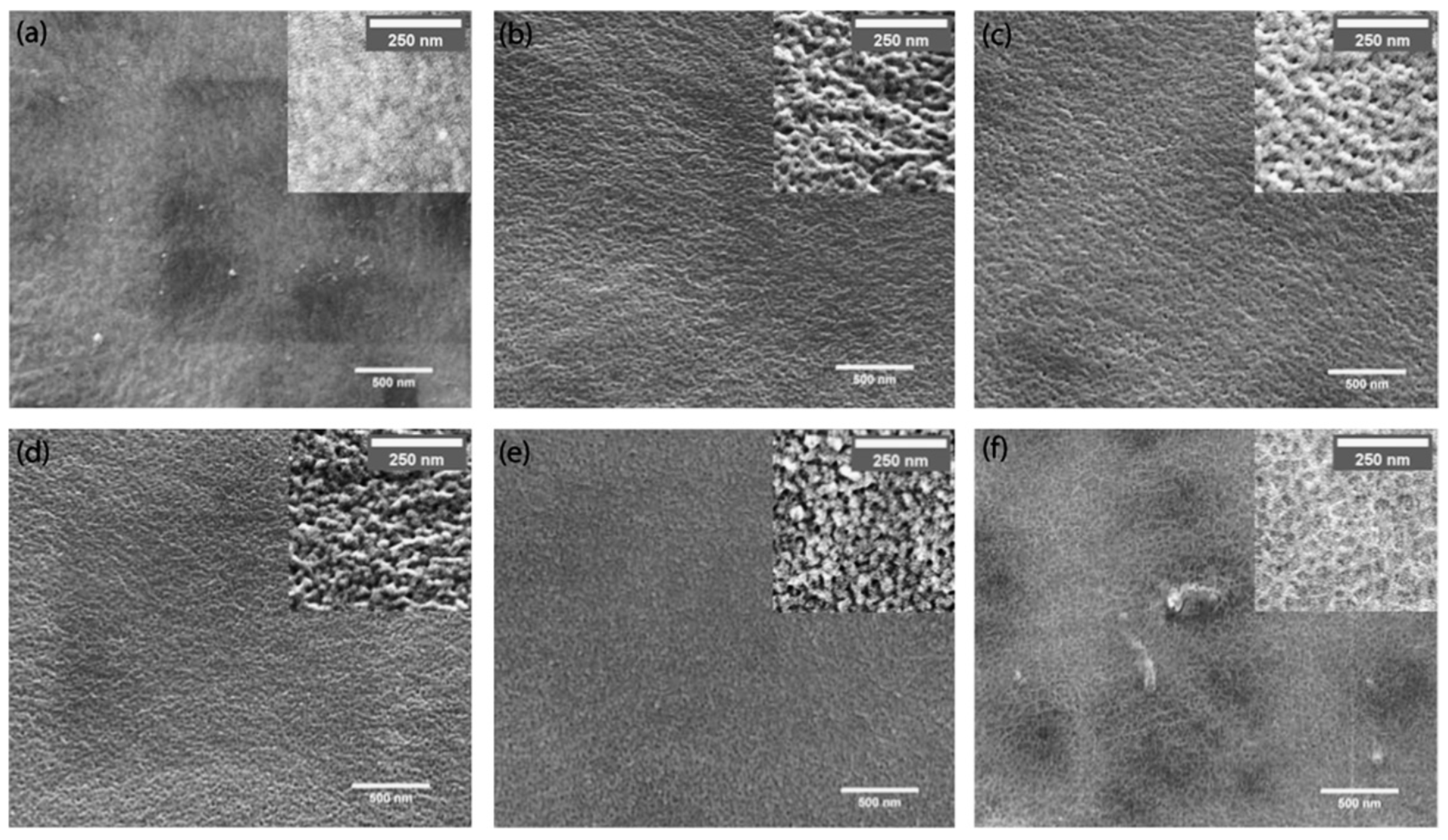
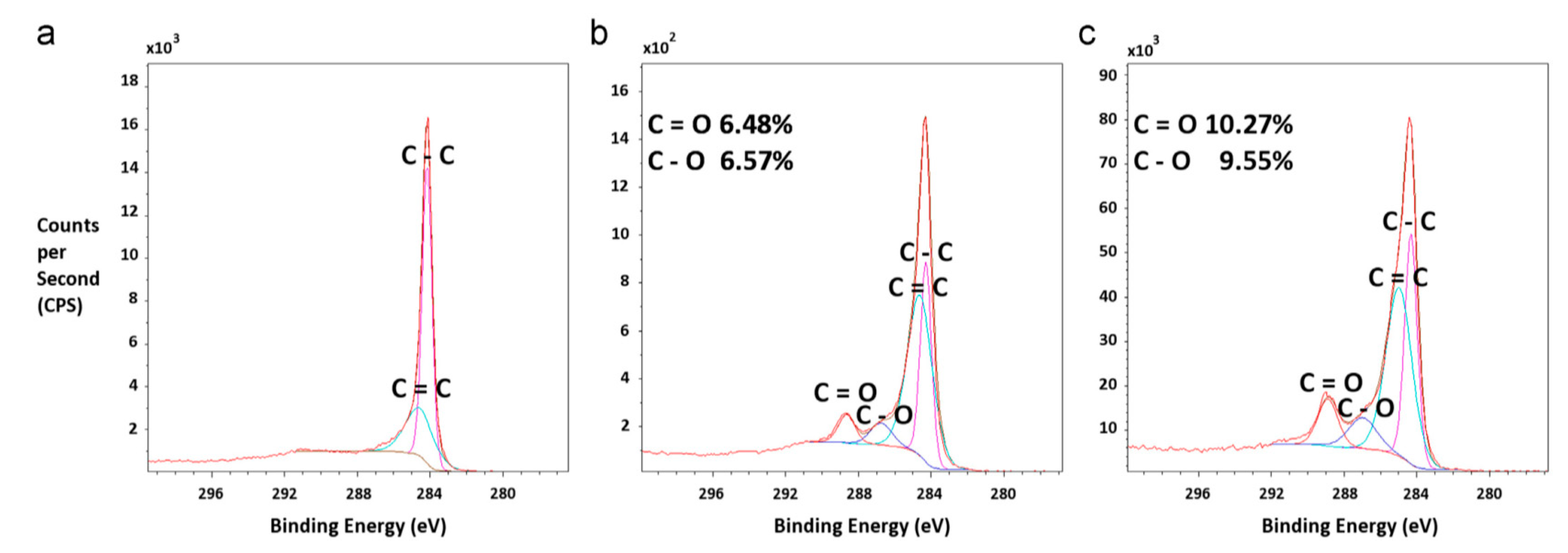
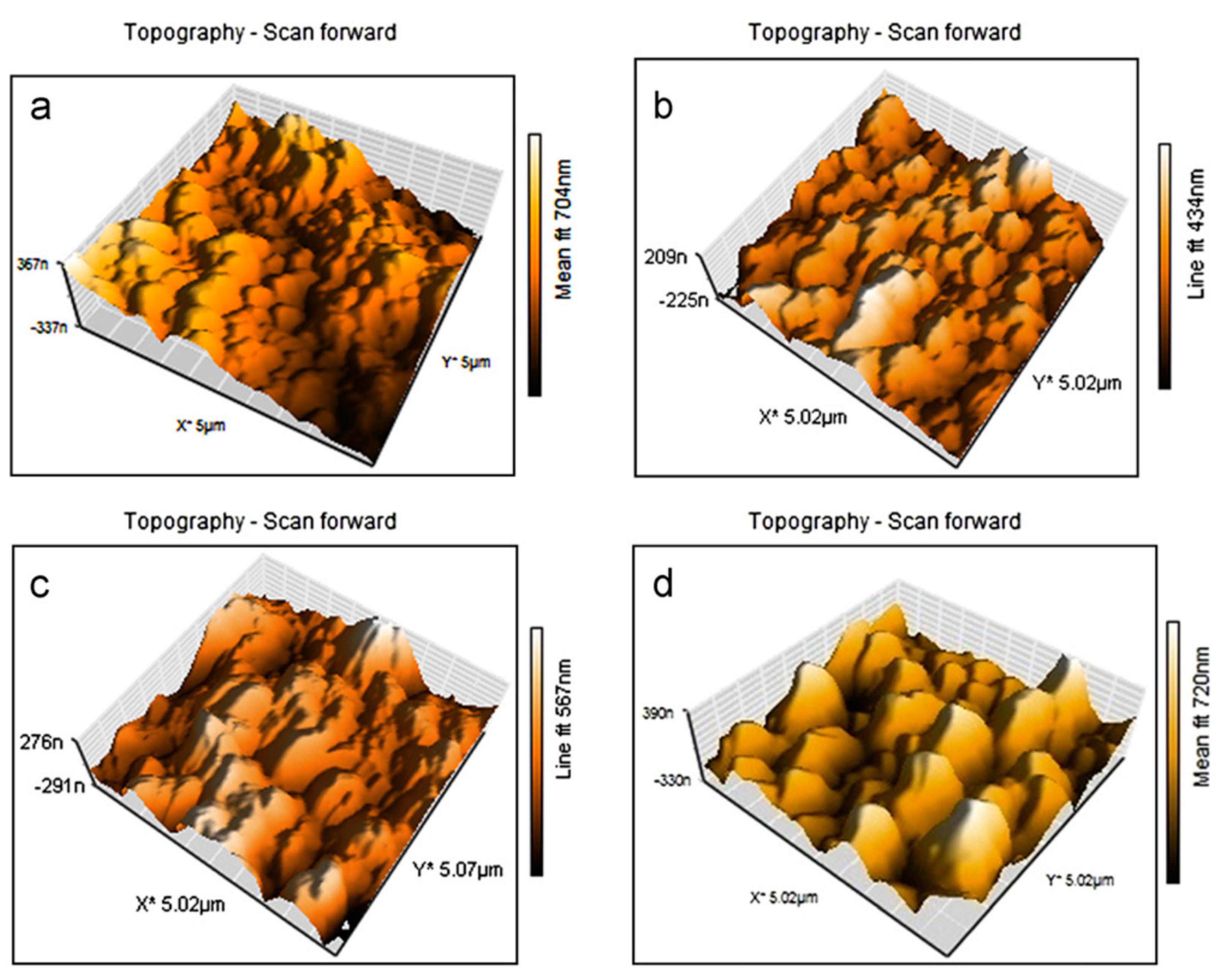
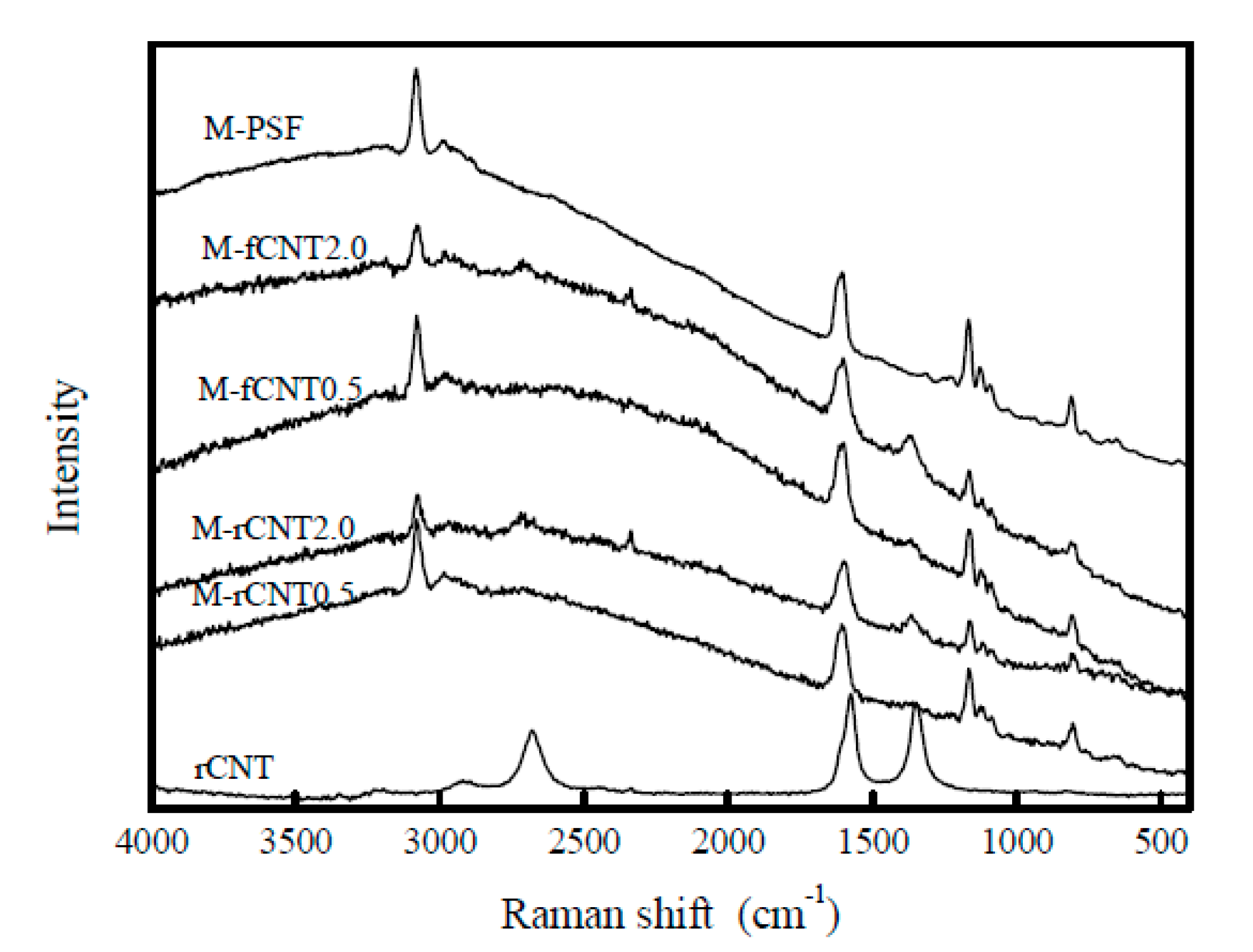
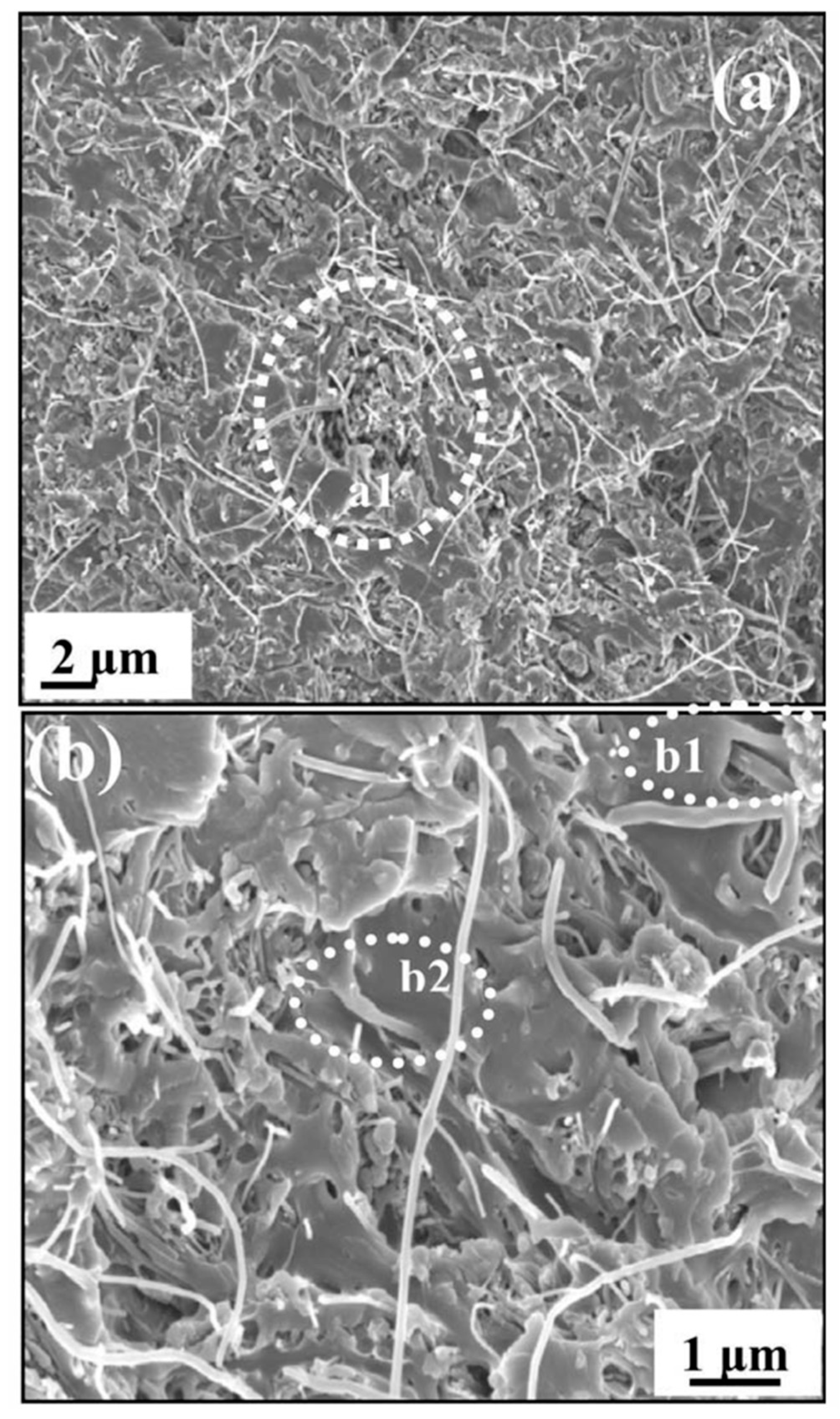
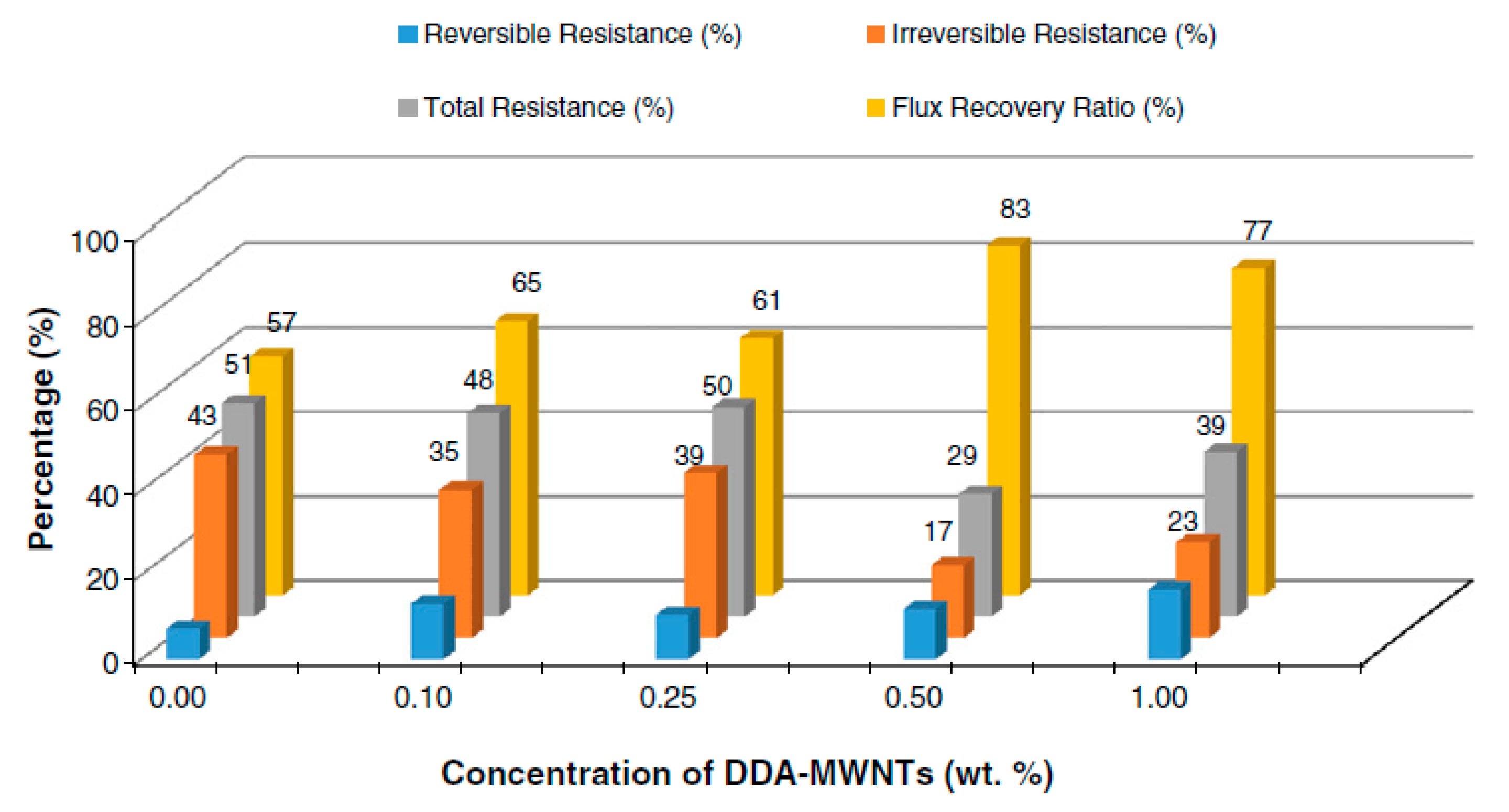
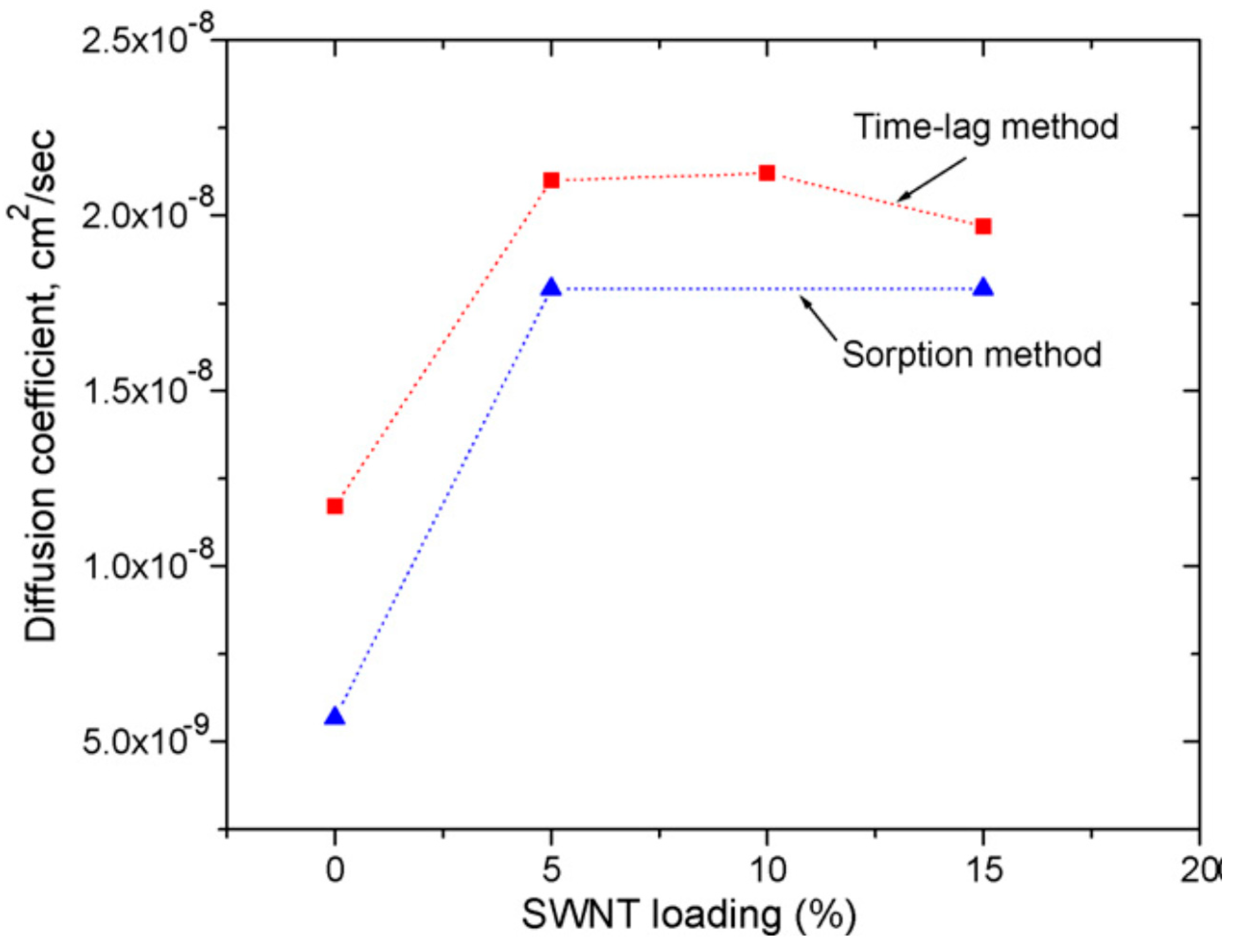
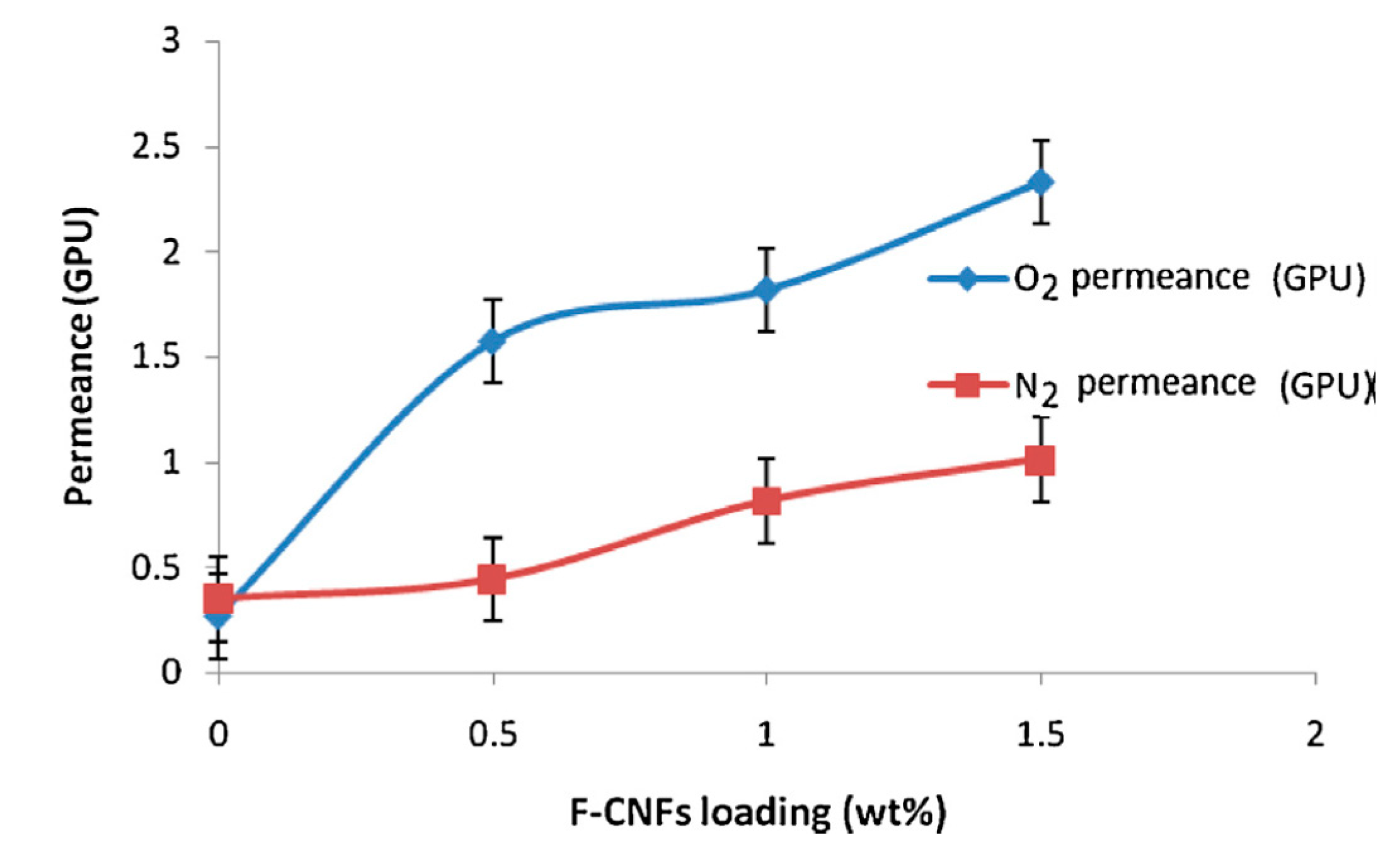
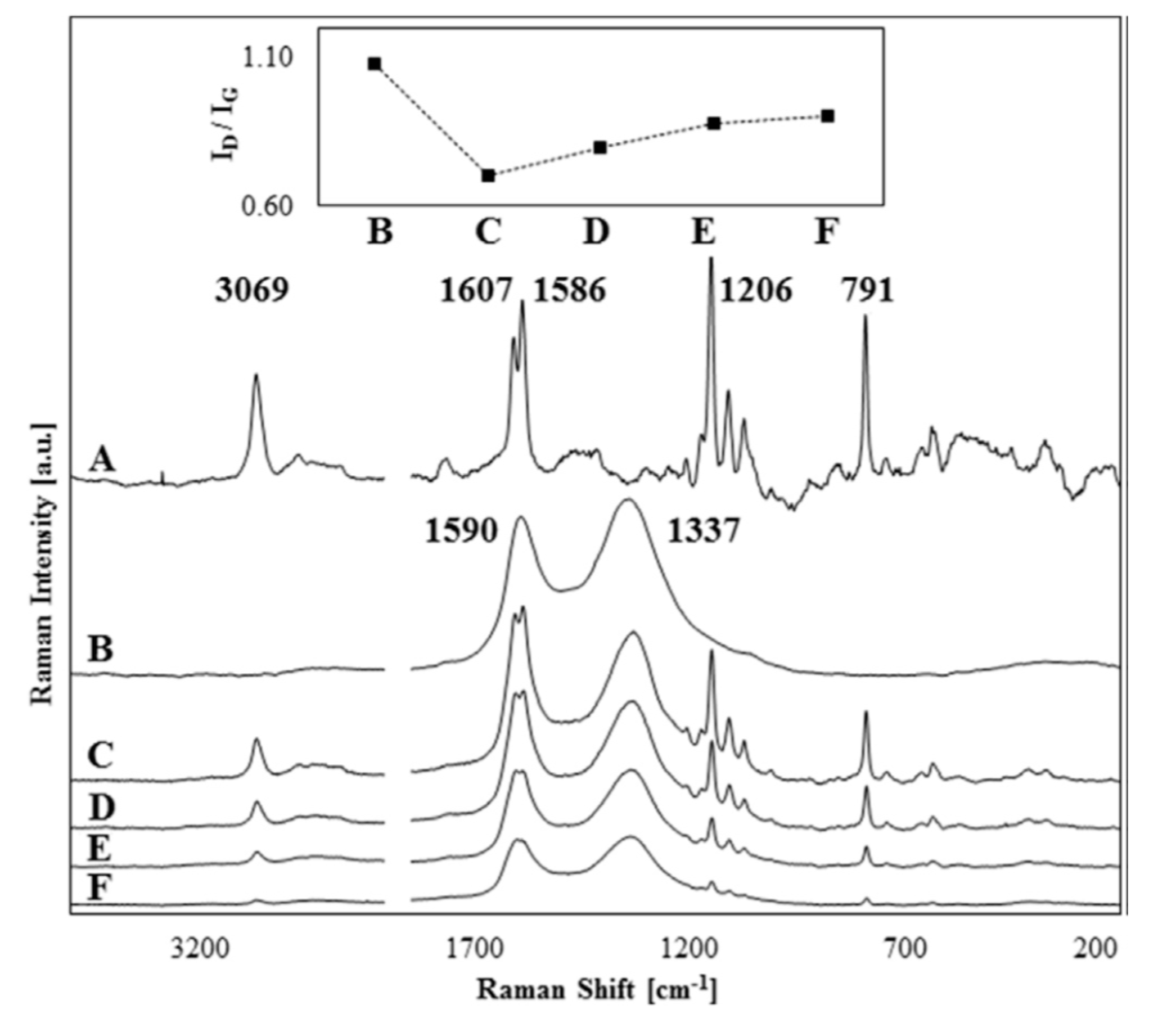
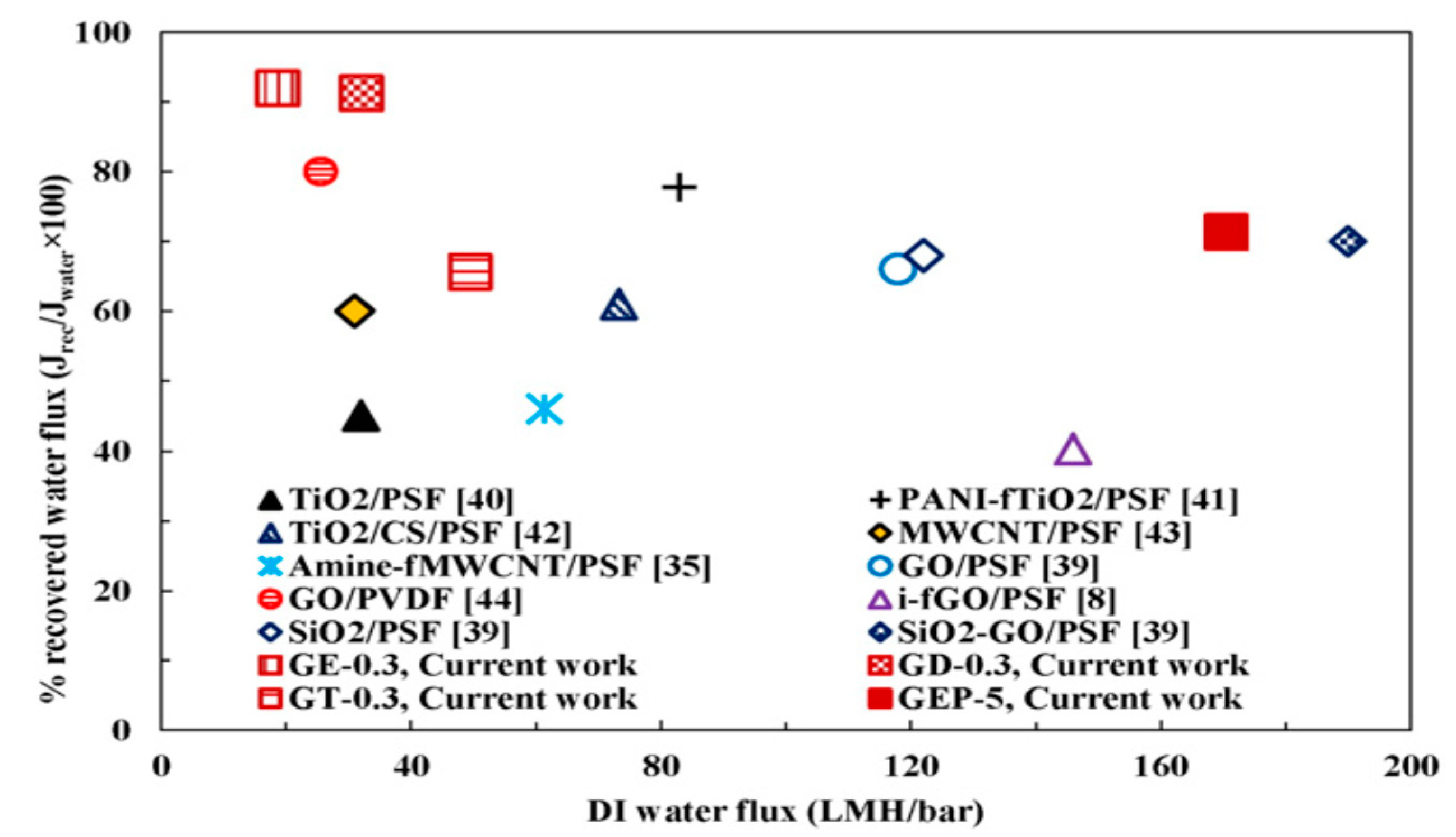

| Particles Used | Modification Performed | Reference |
|---|---|---|
| Pdop coating-MWCNT | Increase antifouling properties and membrane permeability using BSA solution by 19–50%; rejection performances of 99.88%; Good mechanical strength | [30] |
| Oxidized MWCNT | Increase the water flux from 60% to 100%; improve resistance to protein fouling; increase the hydrophilicity of the membrane surface | [31] |
| Carboxylated MWCNT | Increase the tensile strength; improve membrane permeability and surface hydrophilicity; decreased retention and increase leaching | [32] |
| Amine functionalized MWCNT | Improve surface hydrophilicity; increased by 160% the water permeability and present a rejection of NaCl solution between 0.01–0.1 wt.% | [33,41] |
| MWCNT | Improve thermal stability; increase the dielectric constant and dielectric loss | [34,69] |
| Raw CNT and oxidized CNT | Increase the pore size of the top surface; increase the pure water flux by 2 times; lower thermal stability and mechanical strength; high rejection capacity for 2-naphthol solution | [35] |
| CNT doped with N and P | Improvement in hydrophilicity, thermal stability and water uptake capacity; better flow permeation and selectivity; improve the fouling properties by 30% | [37] |
| Carbon nanofibre | Improve membrane thermostability; increase the dielectric constant | [38] |
| MWCNT | Improve tensile strength and modulus; increase materials crystallinity and thermostability | [44,46] |
| Ag doped CNT | Improvement of fouling resistance during BSA solution filtration; slight decrease of water flux with an increase of stability during compaction | [47] |
| C60 | Increase thermal stability and optics properties | [48] |
| Dodecylamine functionalized MWCNT | Increase membrane surface hydrophilicity; improve the fouling resistance and flux recovery | [51] |
| SWCNT and DWCNT modified with amine groups | Increase the adsorption capacity of Pb2+ | [52] |
| Carbon nanoparticles | Decrease membrane porosity and permeability; increase hydrophilicity and tensile properties; increase benzene absorption capacity | [53] |
| MWCNT and TiO2/ | Increase the permeability of the membrane using humic acid as feed solution | [55] |
| Amine functionalized carbon fibers | Extraordinary separation capacity for CO2-CH4 and N2-O2 | [56] |
| SWCNT and MWCNT | Improved the anti-biofouling properties using E.coli cultures | [57] |
| MWCNT and zeolitic imidazole frameworks | improvement in CO2 permeability of composite membranes by three times | [59] |
| CNT functionalized with –COOH, –CONH2, –N3 groups | Increased permeability to ~600 L·m−2·h−1 (LMH); better rejection of Cu (II) than Pb (II) | [60] |
| Carbon nanofibers | Increase membrane permeability from 12.134 Barres to 12.04 and selectivity | [62] |
| MWCNT functionalized with oxide, amide and azide | Increase membrane hydrophilicity with a reduction of flow and flow rate; increase heavy metal retention | [63] |
| Amine and carboxylated CNT | Increase the pore size and water flow at small concentration of nanofillers and decrease it at higher concentration | [65] |
| MWCNT and carbon nanofibers | Increase thermal and mechanical properties | [66] |
| CNT | Superior adsorption capacity for p-chlorophenol; outstanding separation performance after adsorption | [71] |
| MWCNT and MWCNT modified with APTES | Improve selectivity for O2/N2 gas separation | [72] |
| Carboxylated CNT | Improvement in membrane performance for permeability and antifouling abilities; increase membrane tolerance to Cl treatment | [75] |
| Particles Used | Modification Performed | Reference |
|---|---|---|
| Carboxylated GO | Improve thermal and mechanical properties; increase pores size; improve biocompatibility and affinity for cells | [77,79] |
| RGO | Increase antibacterial properties; increase the thermal and mechanical properties; exhibits better resistance to degradation in alkaline solution and good permeability to methanol | [78,84] |
| AgNP-doped GO | Increase antibacterial properties | [80] |
| GO | Decrease the contact angle value; increase the water flux from 8.56 L·m−2·h−1 to 15.3 L·m−2·h−1 and the salt rejection increases from 57.2 ± 4.2% to 76 ± 4.5% | [82,83] |
| GO | Increase the Young’s modulus and traction strength from 153 MPa to 330 MPa and from 3.5 MPa to 5.6 MPa; decrease in water and ethanol flow; positive effect on the proliferation of murine mesenchymal stem cells | [86] |
| Ethylenediamine, diethylenetriamine and triethylenethermine functionalized GO | increased membrane permeability and hydrophilicity; improved structural, mechanical and anti-fouling properties, and a higher recovery flux after BSA solution filtration; increase in water flow | [87] |
| o-ethyl xanate graft onto GO nanoplanes | improvement in water flow of 443.22 L·m−2·h−1; 86.68% heavy metal rejection for Cu2; 88.68% for Cd2+ | [88] |
| GO | Increase membrane hydrophilicity and mechanical properties; decrease membrane permeability and the rejection rate | [92] |
| GO | Increase membrane permeability for isopropyl alcohol; decrease the water flow; decrease the rejection capacity of the membrane | [93] |
| GO | Increase in water hydrophilicity by increasing the pore size; superior mechanical and antifouling properties | [95] |
| GO | Membrane hydrophilicity and the water permeability have increased; increase the absorption capacity for arsenate | [96] |
| Fe3O4-GO | Increase permeability; decrease humic acid retention | [98] |
| TiO2-GO | The irreversible humic acid HA antifouling has been substantially reduced; increase HA retention | [99] |
© 2020 by the authors. Licensee MDPI, Basel, Switzerland. This article is an open access article distributed under the terms and conditions of the Creative Commons Attribution (CC BY) license (http://creativecommons.org/licenses/by/4.0/).
Share and Cite
Pandele, A.M.; Serbanescu, O.S.; Voicu, S.I. Polysulfone Composite Membranes with Carbonaceous Structure. Synthesis and Applications. Coatings 2020, 10, 609. https://doi.org/10.3390/coatings10070609
Pandele AM, Serbanescu OS, Voicu SI. Polysulfone Composite Membranes with Carbonaceous Structure. Synthesis and Applications. Coatings. 2020; 10(7):609. https://doi.org/10.3390/coatings10070609
Chicago/Turabian StylePandele, Andreea Madalina, Oana Steluta Serbanescu, and Stefan Ioan Voicu. 2020. "Polysulfone Composite Membranes with Carbonaceous Structure. Synthesis and Applications" Coatings 10, no. 7: 609. https://doi.org/10.3390/coatings10070609





